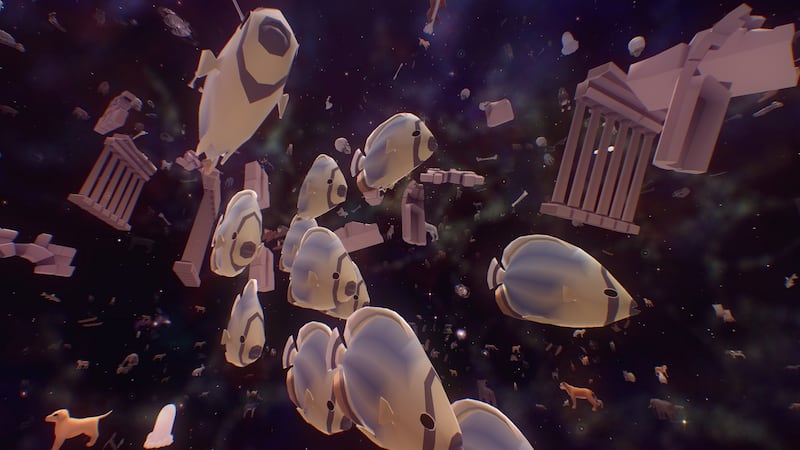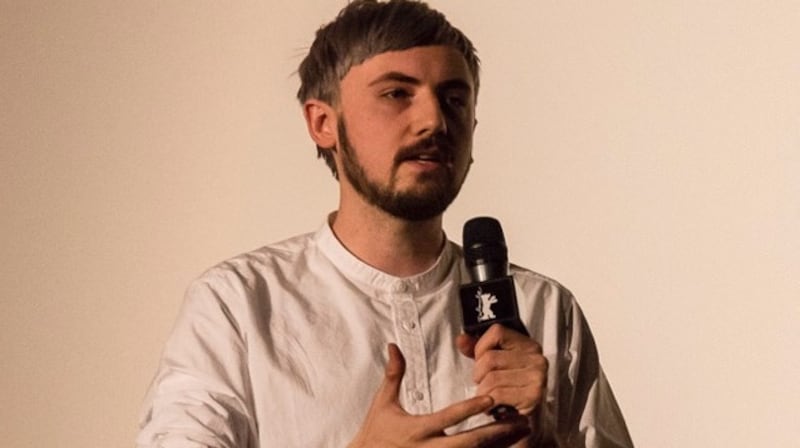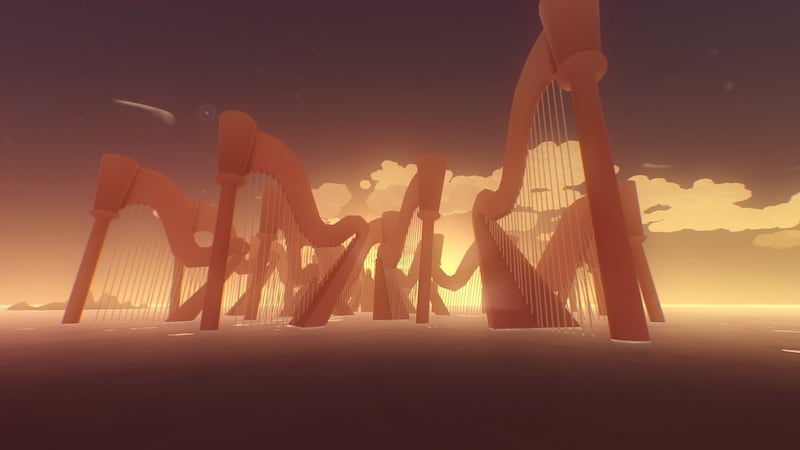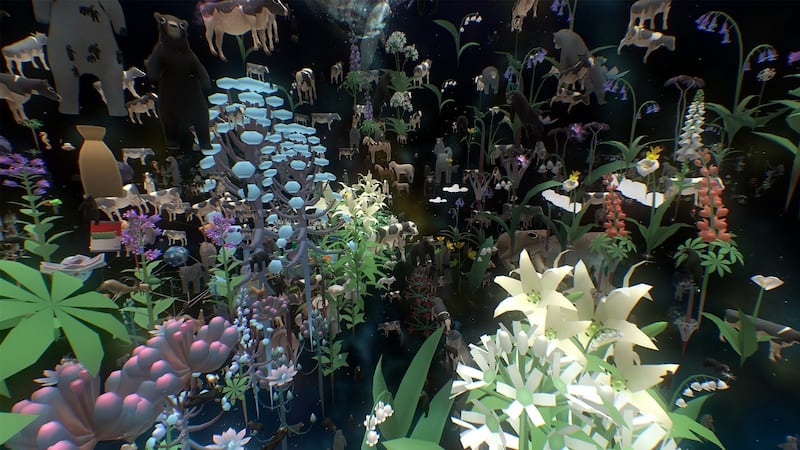David O'Reilly is on the phone from Tokyo. It's nighttime, and a little too loud to concentrate, so he asks his friend to walk on and he'll catch up with them later. He's on a well-earned holiday pierced by a bit of work: an indie game festival, and another gaming event in Kyoto.
The Irish artist, animator and videogame maker's sort-of time off comes in the wake of his game Everything, a piece of work that Wired heralded with the headline, "A must-play game like nothing you've seen before." O'Reilly is from Kilkenny and lives in downtown Los Angeles. He is now in his early 30s, with some landmark pieces of work behind him. What's next? He doesn't want to say.
His previous game, Mountain, was about . . . well, a mountain. Everything is about . . . well . . . okay. It's a simulation game of sorts where players can "be" various objects. It is about the interconnectivity of the universe, of nature; it is about systems and objects being all the same yet all different; it is about infinite environments. Parts are narrated by the British philosopher Alan Watts, and his narration on the trailer for the game brought to mind a tone that Terrence Malick or Ron Fricke might leap towards.

“One of the first things which everybody should understand,” the narration begins, “is that every creature in the universe that is in any way sensitive and in any manner of speaking conscious, regards itself as a human being. It knows and is aware of a hierarchy of beings above it and a hierarchy of beings below it. That is to say, that wherever you are, and whoever you are, and whatever you are, you’re in the middle.”
‘Different points of view’
The underpinning of Everything is obviously and undeniably philosophical. "When people hear the word 'philosophy' a lot of people might fall asleep," O'Reilly says. "But it's really just about different points of view, and that's what it boils down to: creating a system, creating a game or situation, where you can see different points of view. Beyond that, the potential for interpretation is quite large. I never, ever say or talk about what the correct or incorrect way to interpret it is. It's a canvas you can get lost in."
In Everything you can be a tree, or a bug, or a whale, stars, a rock, and on and on. From the initial idea until its completion, it took five years to make, three of those being full-time.

When he was four years old, O'Reilly drew an amazing picture of Bart Simpson. His friend borrowed it to trace over and lost it. Ten years later, O'Reilly's mother wanted him to do something for the summer in Kilkenny. He wasn't athletic, so hurling didn't stick. The Young Irish Filmmakers collective sounded interesting, so O'Reilly checked them out. That meeting happened to be on a day and in a place where two days earlier the animation studio Cartoon Saloon had set up shop. He walked into a room and saw four or five people drawing on animation desks.
One guy was drawing a bird on paper with pencil, and animating it by flipping through the drawings. At that moment, O’Reilly had an overwhelming feeling that this is what he would do. He never realised that “drawing” could be a job before. All through summer, every day after school, and on the weekends, he clicked into this new network.
Commercial projects
After finishing school, he went to IADT in Dún Laoghaire to study animation. At that stage he had already made his own shorts and worked on commercial projects. The lessons being taught were ones he already knew. He moved to London, working at different studios. Went to Italy on a scholarship for a year. He moved to Berlin, suffered through two of their coldest recorded winters in over a century, and then moved to Los Angeles. There was no big plan, but the work started to come: Adventure Land on Cartoon Network, and then the Spike Jonze film Her, for which he directed the video game sequences and worked on storyboards and design. His work can be funny, unsettling, intense and deep. Please Say Something is about domestic violence between a cat and a mouse. In The External World a rabbit's inner thoughts whisper, "I hate myself and everyone around me."

Fundamental to O’Reilly’s work as a 3D artist was his realisation that, like all artists, he was trying to describe the world, “through the medium that is 3D, so the way that some people would describe the world through poetry, or novels, I realised I that I was doing it through this way. All art is a description of the world or the world describing itself. 3D is a great medium to do that in, and even more so because the interactive medium of games is even closer to that, because it’s based on simulations, it’s based on systems which are close to how nature works.”
Everything, then, is part of that and also part of the system it is describing, "Yes, there's nothing that escapes that idea. I could describe the game simply; I could say 'it's about nature', but people see nature as things in opposition to man-made things: trees, flowers, bees. But there are also cities in the game, and cars, and houses, and so the whole thing is that nothing really escapes the word 'nature'. We say 'it's in her nature'. Nature is a very pervasive term that includes everything.
‘Reflecting the world’
“Making something that’s reflecting the world is a thing that we do, and art is something that we’ve always been doing as a species. That isn’t so unique, but the act of when something reproduces? Does a version of itself? A branch could describe itself as a version of a tree, that beautiful word, fractality, and a thing that’s contained within itself. Your question about this is contained within it. Nature from a certain point of view is an incredible echo chamber with infinite variety and we’re all trying to describe it in as faithful a way as we can.”
If this makes O’Reilly sound like a college professor standing at the side of a Tokyo street, then, no. He’s energetic in his explanations and open and chatty.
He talks enthusiastically about games as systems and made up of “layers and layers on top of each other, which is like nature”. When making games, he starts out with the seasons, the time of day, making a nice sunset, making nice transitions between seasons, the wind. “All the things that are a backdrop in other games and films, and this is something that can be brought to the foreground.”
Weather is important (“basic small talk is the weather, it’s the thing that unites us”). Weather is above, and go above that, O’Reilly says, and it’s us rotating around the sun, influencing our lives in more ways than we care to recognise. “Culture is built around these coincidences, these forces above us. Obviously, these things take on a philosophical dimension.”

If O’Reilly was starting out now, he wouldn’t have started in animation, but in code. “Code is an artistic medium I think people in it understand, and people outside it don’t appreciate the creativity of it. It’s the same as maths.”
It's not a big leap to go from animation to code, O'Reilly believes. "The biggest book on animation is called The Illusion of Life. Animation is about giving things life, and when you look at what's possible with code, it's the exact same thing. You can describe, create, and give things life, just in a different way. What's interesting about code is that it's just starting now, it's figuring itself out. When you look at it from the point of view of artistic mediums . . . this is the beginning."
Everything is out now and is published by Doublefine. everything-game.com













